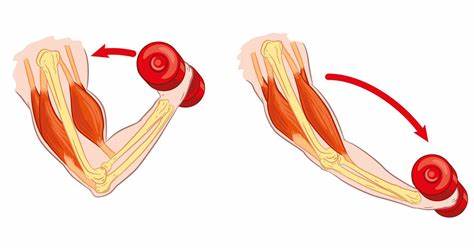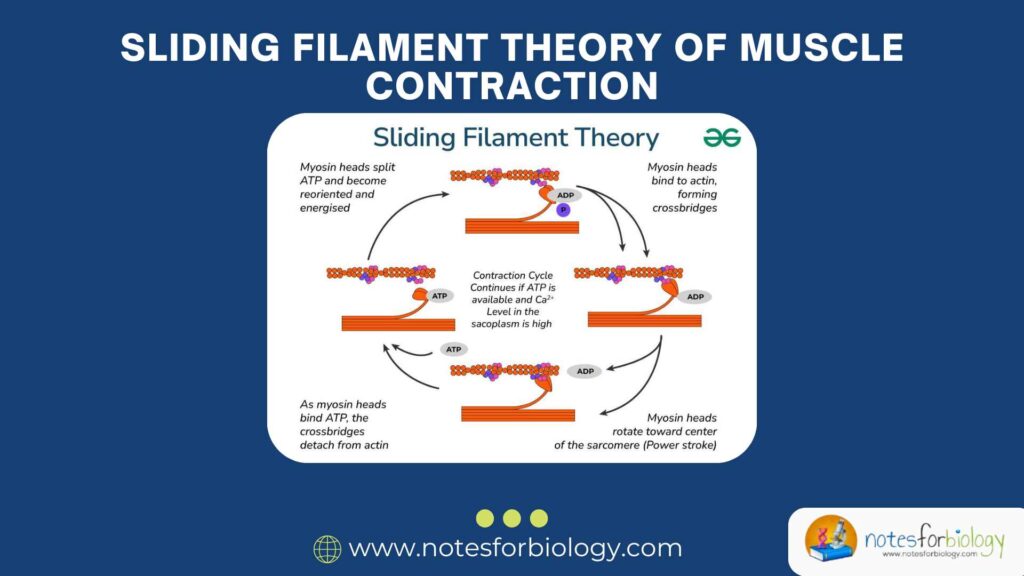Introduction
Muscle contraction is the process by which muscle fibers become shorter and tighter to produce movement. It happens when the brain sends a signal through nerves to the muscles, causing the protein filaments inside the muscle cells (mainly actin and myosin) to slide past each other. This sliding action pulls the muscle ends closer together, making the whole muscle contract or tighten. Movement is a basic function of life. Whether it’s walking, writing, breathing, or even blinking — our muscles make it happen. But how exactly do muscles contract? What happens inside a muscle when we move?

One of the most widely accepted explanations of muscle contraction is the Sliding Filament Theory. This theory describes how muscle fibers contract by the sliding movement of protein filaments within the muscle cells.
Table of Contents
Basic Structure of a Muscle
To understand this theory, let’s first look at the structure of a muscle.

1. Muscle → Muscle Fiber → Myofibrils
- A whole muscle (like your bicep) is made up of bundles of muscle fibers (muscle cells).
- Each muscle fiber contains smaller thread-like structures called myofibrils.
- Myofibrils are the key players in muscle contraction.
2. Sarcomere – The Unit of Contraction
- The sarcomere is the basic functional unit of a muscle.
- It is the repeating unit in a myofibril, like the links in a chain.
- Each sarcomere is made of two main types of filaments:
- Actin (thin filament)
- Myosin (thick filament)
These filaments are arranged in a specific overlapping pattern that allows them to slide past each other.
Key Components Involved
Let’s break down the key structures involved in the sliding filament mechanism:
Actin (Thin Filament)
- A thin protein filament shaped like a twisted strand of beads.
- Has binding sites for the thick filament (myosin).
Myosin (Thick Filament)
- A thick, bulky protein with “heads” that stick out.
- These heads are responsible for grabbing onto actin and pulling it.
Tropomyosin and Troponin
- These are regulatory proteins found on the actin filament.
- They block the binding sites on actin when the muscle is relaxed.
Calcium Ions (Ca²⁺)
- Released inside the muscle cell when a nerve signal arrives.
- They unlock the binding sites on actin by interacting with troponin.
ATP (Adenosine Triphosphate)
- The energy molecule that powers the whole process.
- Needed for both contraction and relaxation of the muscle.
The Sliding Filament Theory: Step-by-Step
Now let’s walk through the full process of how a muscle contracts based on this theory:

Step 1: Nerve Signal Reaches the Muscle
- A motor neuron sends a signal to the muscle fiber.
- This signal causes the sarcoplasmic reticulum (a structure in the muscle) to release calcium ions into the sarcoplasm (fluid inside the muscle cell).
Step 2: Calcium Unlocks Binding Sites
- Calcium binds to troponin, a regulatory protein on the actin filament.
- This causes tropomyosin to move, revealing the active sites on actin.
Step 3: Myosin Heads Attach (Cross-Bridge Formation)
- Energized by ATP, the myosin heads bind to the exposed sites on actin.
- This connection is called a cross-bridge.
Step 4: Power Stroke
- The myosin head bends, pulling the actin filament inward.
- This movement is known as the power stroke.
- As actin slides over myosin, the sarcomere shortens, leading to muscle contraction.
Step 5: New ATP Detaches Myosin
- A new ATP molecule binds to the myosin head.
- This causes the myosin to detach from actin.
Step 6: Myosin Resets
- The ATP is broken down into ADP and phosphate.
- The myosin head returns to its original position, ready to bind again.
This cycle repeats as long as calcium is present and ATP is available.
Summary of Contraction Cycle
- Nerve signal arrives → calcium is released.
- Calcium binds to troponin → binding sites on actin open.
- Myosin binds to actin → power stroke occurs.
- ATP causes myosin to detach and reset.
- Cycle repeats → muscle contracts.
When the signal stops, calcium is pumped back, binding sites close, and the muscle relaxes.
Why “Sliding” Filament?
The term “sliding” comes from what actually happens — the actin (thin) filaments slide inward over the myosin (thick) filaments. This makes the sarcomere shorten, but the filaments themselves do not change in length. It’s the sliding motion that causes the muscle to contract.
What Happens During Relaxation?
When the nerve signal stops:
- Calcium is pumped back into the sarcoplasmic reticulum.
- Troponin and tropomyosin cover the binding sites on actin.
- Myosin can no longer bind.
- The muscle fiber relaxes and returns to its original length.
Importance in Daily Life
- Lift your hand
- Blink your eyes
- Chew food
- Breathe in and out
…your muscles are contracting using this sliding filament mechanism. It happens millions of times a day without you even realizing it!
Summary of Key Terms
| Term | Meaning |
|---|---|
| Sarcomere | Unit of muscle contraction |
| Actin | Thin filament with binding sites |
| Myosin | Thick filament with heads |
| Cross-Bridge | Connection between actin and myosin |
| Power Stroke | Movement of myosin pulling actin |
| ATP | Energy molecule for contraction |
| Calcium Ions (Ca²⁺) | Triggers binding of actin and myosin |
| Troponin/Tropomyosin | Control access to actin binding sites |
Clinical Relevance
Understanding this theory helps in:
- Muscle disease diagnosis (e.g. muscular dystrophy)
- Athletic training (optimizing muscle use)
- Rehabilitation and therapy (after injury or surgery)
- Treatment of fatigue or cramps (linked to calcium or ATP imbalance)
Conclusion
The Sliding Filament Theory explains the beautiful and precise mechanism behind every movement we make. With the help of calcium, ATP, and a complex yet elegant design of protein filaments, our muscles contract and relax effortlessly.
It’s like a microscopic machine working tirelessly in every cell to help you live, move, and be strong.
FREQUENTLY ASKED QUESTIONS
What is muscles contraction ?
Muscle contraction is the process by which muscle fibers become shorter and tighter to produce movement. It happens when the brain sends a signal through nerves to the muscles, causing the protein filaments inside the muscle cells (mainly actin and myosin) to slide past each other. This sliding action pulls the muscle ends closer together, making the whole muscle contract or tighten.
What is the role of calcium in muscle contraction ?
Calcium plays a key role in muscle contraction by starting the process that allows actin and myosin to bind.
When a muscle receives a signal to contract, calcium ions (Ca²⁺) are released from the sarcoplasmic reticulum inside the muscle cell. These calcium ions bind to a protein called troponin on the actin filament. This causes another protein, tropomyosin, to move away from the binding sites on actin. Once these sites are uncovered, myosin heads can attach to actin, and contraction begins.
Without calcium, the binding sites on actin stay blocked, and the muscle cannot contract.
What are the types of muscles contraction ?
Muscle contractions are of three types: isotonic (muscle changes length), isometric (muscle stays the same length without movement), and isokinetic (muscle contracts at a constant speed using special equipment).
Related Articles




